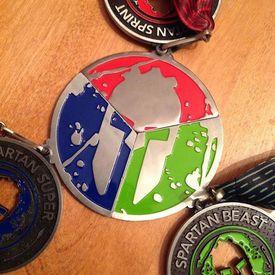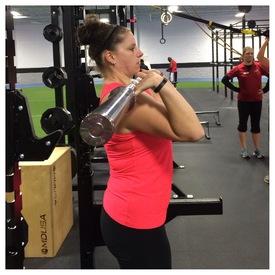In Place of a Road Map: Short N' Sweet

Helloitsdan
Posts: 5,561 Member
This is a short form for the full document contained here:
In Place of a Road Map
The Road Map is simply a tool to find Body Fat%, BMR, and TDEE.
All 3 items are important to understanding fat/weight loss.
Once you know these 3 numbers, you'll be able to manipulate nutrition and training to get to your next goal.
1) Body Fat%
Knowing the ratio of body fat to lean mass is crucial in understanding body composition.
The less fat you have, the leaner you'll look.
The more lean muscle you have, the better your definition (tone) will look.
Having ideal body fat is not only healthier for the individual but it also helps you look good naked!
The shocking part about BF% is most people who PM me numbers don't know how much fat they carry.
It's the most important part of figuring out the rest of your caloric intake.
Bottom Line: Buy a tape measurer or a set of Calipers and learn how to objectively track body fat while cutting/bulking.
The ultimate goal is to lose unwanted fat and maintain or even gain beautiful lean muscle.
Useful links:
Write it down, you'll use it later!
2) BMR/RMR
Basal Metabolic Rate or Resting Metabolic Rate.
This covers all body functions outside of activity.
If you were in a coma and you were fed enough nutrients to keep you alive, That's BMR.
Think "Baseline Calories" if you did absolutely nothing.
Sub-sedentary.
All vital organs are covered when eating BMR.
For those who like math, you'll find several different types of calculations for BMR.
1) Harris-Benedict formula: Overestimates in obese: Avoid this setting!
MEN: BMR = 66 + [13.7 x weight (kg)] + [5 x height (cm)] - [6.76 x age (years)]
WOMEN: BMR = 655 + [9.6 x weight (kg)] + [1.8 x height (cm)] - [4.7 x age (years)]
2) Mifflin-St Jeor: Overestimates needs especially in obese.
MEN: BMR = [9.99 x weight (kg)] + [6.25 x height (cm)] - [4.92 x age (years)] + 5
WOMEN: BMR = [9.99 x weight (kg)] + [6.25 x height (cm)] - [4.92 x age (years)] -1613)
3) Katch-McArdle: Accurate if BF% is known and is especially good in leaner individuals.
BMR = 370 + (21.6 x LBM)Where LBM = [total weight (kg) x (100 - bodyfat %)]/100
If you'd like to calculate on your own, you can get calculated TDEE using this chart:
Multiply BMR x Activity factor = TDEE.
Realize that this isn't just about your training but your lifestyle as well.
Example: You work at a desk all day but come home and play with your children for an hour, lift weights 3x a week for an hour and jog 2mi every other day. In this example id use Moderate or possibly Active settings.
Here's a helpful link for figuring out your BMR and TDEE:
https://www.calculator.net/bmr-calculator.html
Enter all pertinent info.
Make GOAL weight the same as CURRENT weight to get todays TDEE.
Bottom Line: Know what your base caloric needs are and stay above them if you are active.
Eating too low for extended periods of time may allow for weight loss, but you could still have high body fat.
Skinny-fat: https://foodtrainers.blogspot.com/2012/09/are-you-skinny-fat-find-out-why.html
Once you know your base "Comatose" calories you can move on to TDEE.
3) TDEE
Total Daily Energy Expenditure
This is the total amount of calories you burn in a 24hour period.
You wake up, brush your teeth, lift, run, play, work.....
You get the idea.
One thing I've noticed over the years is people underestimate activity.
They say "I'm sitting at my computer all day long so i'm sedentary!"
I'll ask "Workout routine?"
They say "Oh i run for 3 hours a day and do CrossFit all weekend long!"

If you sit all day and barely walk and don't work out, Sedentary.
If you work out 1-2x a week, Light.
If you work out 3-5x a week, Moderate.
If you work out 5+, active/very active.
You'll find these numbers at the bottom of the BMR page in Fat 2 Fit.
You can also use other calculators around the internet.
Once you have TDEE you can decide what to set MFP calories to.
I recommend -20% for individuals who are Obese and under.
-30% for individuals who are Obese and over.
Bottom Line: Be realistic with the activity. If you are a marathon runner trying to take a few pounds off, don't use sedentary settings. First, start with the top number that applies to you and stick with it for several weeks. If nutrition is right and activity is right, you should maintain eating TDEE. To lose fat, subtract calories. To gain LBM, add calories. Lift weights, walk, sleep and eat right.
Use your common sense.
In Place of a Road Map
The Road Map is simply a tool to find Body Fat%, BMR, and TDEE.
All 3 items are important to understanding fat/weight loss.
Once you know these 3 numbers, you'll be able to manipulate nutrition and training to get to your next goal.
1) Body Fat%
Knowing the ratio of body fat to lean mass is crucial in understanding body composition.
The less fat you have, the leaner you'll look.
The more lean muscle you have, the better your definition (tone) will look.
Having ideal body fat is not only healthier for the individual but it also helps you look good naked!
- Athletes (6-13% for men, 16-20% for women) <---Ideal area for Bulking
- Fitness (14-17% for men, 21-24% for women)
- Acceptable (18-25% for men, 25-31% for women)
- Obese (25%+ for men, 32%+ for women)
The shocking part about BF% is most people who PM me numbers don't know how much fat they carry.
It's the most important part of figuring out the rest of your caloric intake.
Bottom Line: Buy a tape measurer or a set of Calipers and learn how to objectively track body fat while cutting/bulking.
The ultimate goal is to lose unwanted fat and maintain or even gain beautiful lean muscle.
Useful links:
- https://www.calculator.net/body-fat-calculator.html
- https://www.calculator.net/army-body-fat-calculator.html
Write it down, you'll use it later!
2) BMR/RMR
Basal Metabolic Rate or Resting Metabolic Rate.
This covers all body functions outside of activity.
If you were in a coma and you were fed enough nutrients to keep you alive, That's BMR.
Think "Baseline Calories" if you did absolutely nothing.
Sub-sedentary.
All vital organs are covered when eating BMR.
For those who like math, you'll find several different types of calculations for BMR.
1) Harris-Benedict formula: Overestimates in obese: Avoid this setting!
MEN: BMR = 66 + [13.7 x weight (kg)] + [5 x height (cm)] - [6.76 x age (years)]
WOMEN: BMR = 655 + [9.6 x weight (kg)] + [1.8 x height (cm)] - [4.7 x age (years)]
2) Mifflin-St Jeor: Overestimates needs especially in obese.
MEN: BMR = [9.99 x weight (kg)] + [6.25 x height (cm)] - [4.92 x age (years)] + 5
WOMEN: BMR = [9.99 x weight (kg)] + [6.25 x height (cm)] - [4.92 x age (years)] -1613)
3) Katch-McArdle: Accurate if BF% is known and is especially good in leaner individuals.
BMR = 370 + (21.6 x LBM)Where LBM = [total weight (kg) x (100 - bodyfat %)]/100
If you'd like to calculate on your own, you can get calculated TDEE using this chart:
Multiply BMR x Activity factor = TDEE.
- 1.2 = Sedentary (Little or no exercise + desk job)
- 1.3-1.4 = Lightly Active (Little daily activity & light exercise 1-3 days a week)
- 1.5-1.6 = Moderately Active (Moderately active daily life & Moderate exercise 3-5 days a week)
- 1.7-1.8 = Very Active (Physically demanding lifestyle & Hard exercise or sports 6-7 days a week)
- 1.9-2.0 = Extremely Active (Hard daily exercise or sports and physical job)
Realize that this isn't just about your training but your lifestyle as well.
Example: You work at a desk all day but come home and play with your children for an hour, lift weights 3x a week for an hour and jog 2mi every other day. In this example id use Moderate or possibly Active settings.
Here's a helpful link for figuring out your BMR and TDEE:
https://www.calculator.net/bmr-calculator.html
Enter all pertinent info.
Make GOAL weight the same as CURRENT weight to get todays TDEE.
Bottom Line: Know what your base caloric needs are and stay above them if you are active.
Eating too low for extended periods of time may allow for weight loss, but you could still have high body fat.
Skinny-fat: https://foodtrainers.blogspot.com/2012/09/are-you-skinny-fat-find-out-why.html
Once you know your base "Comatose" calories you can move on to TDEE.
3) TDEE
Total Daily Energy Expenditure
This is the total amount of calories you burn in a 24hour period.
You wake up, brush your teeth, lift, run, play, work.....
You get the idea.
One thing I've noticed over the years is people underestimate activity.
They say "I'm sitting at my computer all day long so i'm sedentary!"
I'll ask "Workout routine?"
They say "Oh i run for 3 hours a day and do CrossFit all weekend long!"

If you sit all day and barely walk and don't work out, Sedentary.
If you work out 1-2x a week, Light.
If you work out 3-5x a week, Moderate.
If you work out 5+, active/very active.
You'll find these numbers at the bottom of the BMR page in Fat 2 Fit.
You can also use other calculators around the internet.
Once you have TDEE you can decide what to set MFP calories to.
I recommend -20% for individuals who are Obese and under.
-30% for individuals who are Obese and over.
Bottom Line: Be realistic with the activity. If you are a marathon runner trying to take a few pounds off, don't use sedentary settings. First, start with the top number that applies to you and stick with it for several weeks. If nutrition is right and activity is right, you should maintain eating TDEE. To lose fat, subtract calories. To gain LBM, add calories. Lift weights, walk, sleep and eat right.
Use your common sense.
Tagged:
11
Replies
-
:drinker:1
-
 1
1 -
:flowerforyou:0
-
Thank you! I have been sharing this with all of my friends as well.0
-
bump0
-
Bump!!1
-
Well done, Dan.
Thank you for doing this.0 -
great job.0
-
In! For the awesomeness!0
-
This is wonderfully simplified. Thank you, Dan.0
-
Concise. I like that. :drinker:0
-
Thanks so much for helping me understand this process!!0
-


 0
0 -
So do I eat back my calories or what? Just kidding thank you for this!2
-
Nicely simplified! Thanks again, Dan!0
-
Nice, thank you! Again!1
-
:drinker:0
-
Concise, to the point! Excellent!:happy:0
-
Thank you for taking the time, again!0
-
This was much easier to understand (than the other roadmaps) for a newbie like me, thanks!0
-
These are static numbers unless you want to bulk.
So dont eat back calories.
If you are lifting and looking to add lean mass, set MFP to TDEE and eat back lifting exercise calories on that day.
That will put you in a surplus.0 -
bump0
-
bump.0
-
Use your common sense.
This is where people fall short. Great post, thanks!0 -
:flowerforyou:0
-
????????????????❤0
-
Thanks, hopefully can get it right now.0
-
bump0
-
:drinker:
Great info - thanks!0 -
Nice work, thank you!0
This discussion has been closed.
Categories
- All Categories
- 1.4M Health, Wellness and Goals
- 398.2K Introduce Yourself
- 44.7K Getting Started
- 261K Health and Weight Loss
- 176.4K Food and Nutrition
- 47.7K Recipes
- 233K Fitness and Exercise
- 462 Sleep, Mindfulness and Overall Wellness
- 6.5K Goal: Maintaining Weight
- 8.7K Goal: Gaining Weight and Body Building
- 153.5K Motivation and Support
- 8.4K Challenges
- 1.4K Debate Club
- 96.5K Chit-Chat
- 2.6K Fun and Games
- 4.8K MyFitnessPal Information
- 12 News and Announcements
- 21 MyFitnessPal Academy
- 1.5K Feature Suggestions and Ideas
- 3.2K MyFitnessPal Tech Support Questions
























